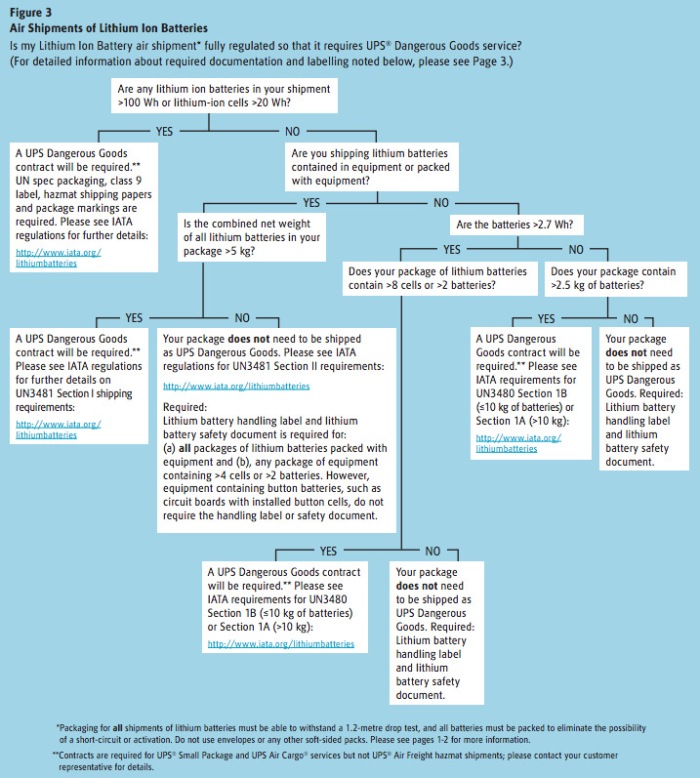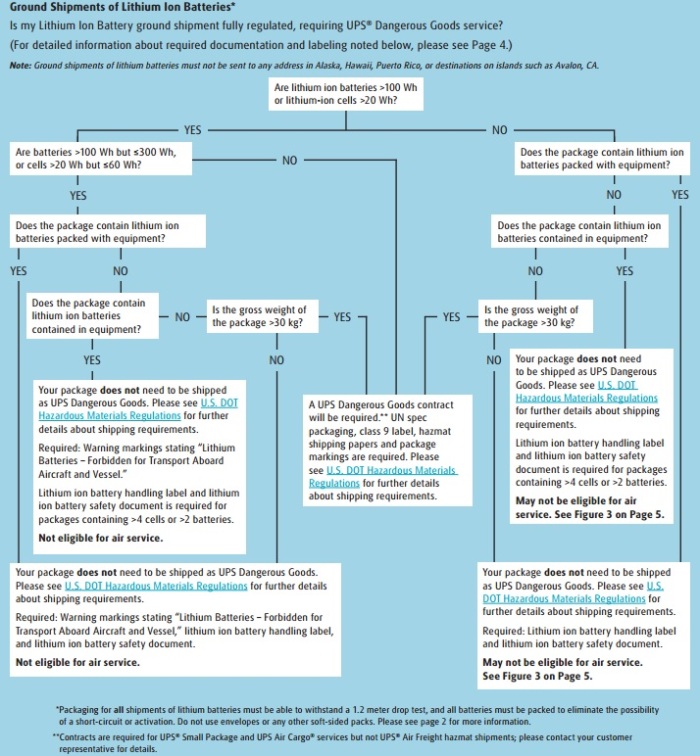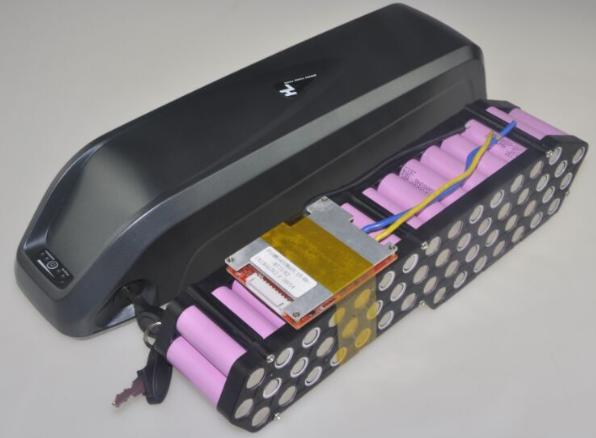Of the 6 e-bike batteries I’ve bought online, I believe that only 2 of them have actually been shipped quasi-legally. This article is about how your vendor is supposed to ship you batteries and why the often don’t. Eventually, this skirting of the law is going to get the e-bike business into big trouble, but up till now it’s been mostly under the radar. When it comes to the ebike business, Haz Mat shipping is the elephant in the room that no one really wants to talk about, or think about, or deal with on any real level.

Lithium batteries improperly packaged, declared and shipped. Don’t let this happen because of you.
Like most things that the transportation industry doesn’t understand they tend to err on the side of caution. Since Lithium batteries can explode if they are handled too roughly or are punctured there has been an insane amount of regulation for these batteries in the last several years that has only gotten worse. Shipping a large Lithium battery within the US legally can easily run over $60 and shipping one into the US from China can easily be double or triple that. It’s no wonder than many unreputable Chinese companies and many US companies have chosen to not follow the letter of the law when it comes to transporting these batteries. As a consumer, how can you know if you are going to get the battery you purchased that is going to ship to you without hassle, delay or confiscation?

Think it won’t happen to you? Ever heard of a little e-bike company called BionX? They were recently fined $18,000.
Why don’t people ship e-bike batteries ‘by the book‘? Three main reasons:
- It’s a pain in the ass for them
- It’s really expensive, often 2-3 times more than shipping them without the proper paperwork and it takes a lot of time
- They actually don’t know how to do it properly and are too lazy to figure it out
I spent several hours researching the correct way to ship batteries and it is incredibly complicated. There are different restrictions for what you need to do based on the size & power of your battery as shown below.

Confused yet? The regulations get even worse the deeper you go down the rabbit hole. This chart is for air shipments.
So what do you do if you have damaged or leaking Lithium cells? Ironically there is no way to legally ship these that I can find. There is also no proper way to recycle damaged batteries. When I did my Bosch training we were told to bury them in sand in a large metal coffee can and leave it outside for a month till it was done reacting then throw the WHOLE PACK away. That’s right, throw that $1000 battery pack in the garbage can. Lithium cells do not have rare materials in them and if they are damaged you have no other real option.
Does this make any sense at all? From this article here I found the following statistic:
From March 1991 to August 2010, batteries and battery-powered devices caused 113 recorded incidents with smoke, fire, extreme heat or explosion on passenger and cargo planes … The estimated failure rate of Li-ion is one per 10 million. Examining the 113 recorded incidents of transporting batteries by air in 19 years reveals that most failures occurred due to inappropriate packaging or handling, causing damage or electrical short.
This was the primary reason that Lithium Batteries started to be restricted on Passenger flights in the US.
How big does a battery generally have to be before serious regulations go into effect?
Most 300Ah batteries or bigger fall under special shipping restrictions, although the regulations change from one carrier to another. Every ebike battery I own is over 300Wh with my smallest being a 36v 10ah battery (36×10=360aH).
How do I know if my vendor will ship me batteries legally?
There is only one way to find out, ask them before you order the battery. If you don’t then your battery could be delayed in shipping for hazmat inspection or seized (this really does happen). Almost every non-reputable Chinese battery reseller has found some way to skirt the laws when it comes to shipping batteries, but it’s just not going to last. Already the customs & freight inspectors have wised up to people who just slap 300Wh stickers on ebike batteries that are clearly over 300Wh. The problem will only get worse as more lithium batteries cause more problems for shippers. If you want to watch a video that will make your blood run cold click here and think about what’s going to happen when an accident like this is caused by a lithium battery not labeled and packaged properly.
What do I do if I have a puffy, damaged or leaking battery?
This is something everyone will have to deal with personally at some point or other. Hobby King has a pretty strict no-refund policy on their Lipo batteries unless they arrive DOA from the factory. That has led many people to video record the opening and testing of the batteries when they get them from the shipper. If they have a problem they send the video to HK and then get fresh batteries shipped directly to them. The bad batteries just get thrown away. If I was asked to ship a damaged, swollen or leaking battery back to my vendor, I’d probably just refuse. Frankly it’s just not worth risking serious fines just so they can get their non-working battery back. If the battery was dead or had a dead cell or a bad BMS then I would probably just comply and send it back as that actually is legal.
This puts e-bike battery sellers in an impossible position. Now you begin to see why Hobby King has a no-refund policy on their batteries. The problem gets even worse when if the batteries are charged at too high of an amperage rate or are physically abused and then stop working and the customer demands a refund or a replacement battery. You can see that selling e-bike batteries is a business that really no one in their right mind would want to be in.
The newer Chinese cases allow batteries to be put in without being spot welded and then the case is just screwed together. Could this be the answer we seek?
What is the solution to this stupid problem?
I have spent a lot of time thinking about this while sitting on the squatty potty and I have come up with an ingenious solution that absolutely no one is doing yet (that I know of). Sell the ebike batteries in kits and ship the batteries in separate shipments of 300Wh or less without Haz Mat declarations. The buyer gets their battery kit in several different shipments, one with the case and 300Wh of batteries and a couple other shipments of loose 18650 cells of 300Wh or less. They unscrew the case which has contacts for the batteries instead of spot welding (see image) and just put the cells in with the proper orientation and screw it back together. If one of the batteries gets put in backwards then it will blow up in their face but if the kit buyer is not a complete idiot then it should work. Of course, if you make the kit idiot-proof, then someone will probably just make a better idiot.

You can see if you ship ground and the batteries are <300Wh and shipped ground you can get them through with minimum regulations if you ship the cells ground.
In addition, if a cell goes bad then the users can take apart their own packs and test the individual cells with a multimeter or individual battery tester like this one from Lunacycle.com . They can then just order replacement 18650 cells from a reputable vendor and pop a new cell in and screw the pack back together. This could make existing e-bike packs last a lot longer if just one cell in the pack goes bad.
I do think that the shipping restrictions for Lithium batteries border on insane in the US. It’s the one big thing that is holding the industry back in a big way. Just because laws are stupid does not mean that it’s OK to break them whenever we want, so from that point of view it makes sense to follow them the best we can when we can. If you are an e-bike battery vendor it might also make a lot of sense for you to have a large umbrella insurance policy.
This is life and sh!t happens.
Ride On.





I like the idea of being able to swap out a bad cell, but I’m concerned that it won’t balance with the other original cells in the pack.
LikeLike
With a smart BMS it would be fine, even a stupid BMS will balance a battery if you leave it on the charger for long enough. The biggest problem is putting it in the case with it’s voltage being different than the other cells in that grouping. If the voltage is off by much the cells will try to instantly equalize which could cause major problems. *BOOM* Your best bet would be to swap out all cells in that grouping (probably only 4-5 of them) which would work if the replacement cells were all fully charged (they should be). No explosions.
LikeLike
I didn’t realize there was a case that could be used without spot welding. I know NTS and Saiki were working on this, had a Kickstarter that involved a non-welded case. But the KS ended with Saiki leaving the building, and a lot of people wondered if it would ever happen.
The last time I bought LiPo batteries from the hobby monarch, they came in a plain box via Priority Mail, so they were air shipped, just judging by the time frame. Since LiPos are rather explosive, this seemed unwise. I assume the limit is 300 wh (sometimes you say AH) so maybe these hobby shipments are legal. LiFePo4 batteries are lower energy density and considered much safer, but I don’t know if they avoid any restrictions. I’m sure they are on the way out, though I use a LiFePo pack every day.
One Chinese vendor blatantly advertises that they mislabel their battery shipments to get around Customs or other requirements. They are very upfront about it, but I’m not sure they have thought this through.
https://goo.gl/photos/YttwzJWPyRaANud99
(Click the only image)
I noticed that LunaCycle says they comply fully with the HazMat rules, on their batteries. Their prices are reasonable enough. Paul at EM3ev says the same thing, but his shipping costs put him at a huge disadvantage.
Ultimately, people have the packs in their houses (or 40 story apartment buildings) and they charge them. I figure they have to be made like, totally mega-safe, whether shipping them or not. It’s not like Teslas don’t sit in ground floor parking garages beneath huge office buildings. The failure that precipitated the Pedego recall turned out to be quite high, maybe 1 in 1000. I think those packs had Chinese cells.
It’s a problem because no one is really saying what a safe pack actually would be, what sort of protections eliminate the risk, or what quality level of each cell insures the cells doesn’t go bad. So it’s a serious thing, but there is no reason small ebike companies and kit vendors can’t lead the way. The big companies have never been honest about batteries, come to think of it.
At least the battery prices have come down. Even if the vendors have to hire a guy to go around the country in his Gremlin and drop them off, there has to be some way to sort this out.
Great job. I’ll pass this around.
LikeLike
It’s common for Chinese companies to openly skirt the regulations. Crazy, actually. They can get in deep trouble for that. I made a mistake and referenced Ah instead of Wh, that has been corrected and the ground shipping information has been added.
LikeLike
There was some sticker shock at the shipping cost from EM3ev, but doing it right is the way to go. I know he offers to ship other items in a separate shipment without all the hazmat cost.
LikeLike
I’m remained disappointed and frankly very surprised that no one has marketed a case and kit that uses compression instead of welds. I’d buy several in a flash! Hopefully it will happen. The guy now doing the NTS design won’t sell a kit either. Bummer.
LikeLiked by 1 person
I believe the problem is the liability when a customer fills in the cell slots and screws the pack together. All of the series groups will be fine. For instance, you can connect 12V battery to a 36V battery to make a 48V battery, no sweat. The problem is in the parallel groups. If a full cell and a half-full cell are put in the same parallel group, they will try to equalize rapidly. Even if they do not catch on fire, they will definitely still be damaged, at the very least. A small percentage of customers will be unscrupulous, and threaten smear the company if they don’t get a full refund, even though it was all their fault.
LikeLike
Thanks very information and you raise excellent points. As someone in the market for a battery, I am considering building one. However, since I have never done that before, it seems to be a daunting task at this point. I do like your idea of a kit. You could probably ship the kit in several USPS flat rate boxes.
LikeLike
Can someone clarify the rules regarding transporting Li ion batteries on a homebuilt ebike in your own car while crossing the border from Canada to the US and back for the purposes of a vacation trip?
LikeLike
I am adding a 750 watt Bafang mid drive to my long time ground transportation Montague folding mt. bike for my homebuilt kitplane. I received the 52 VDC battery yesterday from Luna Cycle, and as expected it is quite compact. BUT, the preferred area to carry it inflight (separate from the bike for center of gravity reasons) is pretty much underneath my 6 gallon aux fuel tank. I would prefer not to be concerned with this….., and if it is enough of a potential problem I can carry it outside the airplane, strapped to a lift strut. More drag, but it beats catching on fire?
I should mention that the plan is to recharge the battery inflight, via a 300 watt or so 12 VDC to 120 VAC converter, I have about 12 to 15 amps @12 VDC available inflight, I am still not sure what type AC charger I’ll be using, and thus its 12 VDC requirements.
LikeLike
Throw it in a metal box for transport that’s what I would do. The fumes can be bad if it burns, but if you don’t charge it too fast or at too high power it is extremely unlikely to explode. I’ve abused the hell out of packs and I’ve never gotten one to explode.
LikeLike
So based on the UPS lithium safety document, they don’t want to ship the common batteries we’re talking about. I’m talking to a seller with a 52V 13.5 Ah battery that exceeds their 300 Wh limit on their forms. Otherwise, the box needs a hazmat label and needs to be packed for a 1-2 meter drop. bubble wrap>box>bubble wrap> box?
other ways to ship a battery? Get it to an ebike retailer and leverage their expertise?
Thanks
LikeLike
I’m also a pilot with an experimental a/c (Sonex Waiex) and for W&B reasons the previous owner needed to lighten up the firewall forward section after switching to water-cooled heads on the Jabiru 3300. He went to a LiFePo4 battery pack. They make them for power sports (motorcycles mainly). Ballistic is one company that makes them. I have a 4s4p pack from them made from 26650 cells. I also have an emergency backup pack made from flat cells that’s10ah. I’d strongly recommend going the LiFiPo4 route. Just the idea of a large regular lithium battery on a small airplane gives me the willies, and one near a fuel tank is terrifying.
BTW one of the other reasons they use LiFePo4 is the charge voltages. 3.6 vs 2.4 for lead acid means you can use 4 where you’d have 6 cells, with no change needed for the charging system. 4 LiFePo4 is the same 12v nominal/14.4 charged. The Ballistic packs even come with a standard balancing port. So does the backup pack (I carry that so I can backfeed into the panel in case the alternator goes out (all instruments are in the glass panel, and i fly at night, (intending to add at least a mechanical altimeter and ASI – the previous owner was a sport pilot, so he couldn’t fly at night and wasn’t as concerned about losing all of his instruments))
BTW, what do you fly?
LikeLike
I’m not an electrical or electronic engineer, but it seems to me that the smart solution all around would be to design a pack that uses modular subpacks that are each less than 100Wh and install into the larger pack in some keyed manner. It would avoid a lot of the potential user error problems that could arise with single cells (e.g., installing cells backwards).
If the manufacturer were especially paranoid they could even construct the keying so the subpacks don’t come back out once they’re installed. That would help avoid people mixing old and new cells, charged and uncharged cells, etc.
LikeLike
Hello Guys,
I am just reading this now. But at Engineering Spirit, The Netherlands, we have a BMS solution that allows multiple packs to be paralleled. After an initial delay, all packs will be active in the charge and discharge modes.
This concept can easily be applied to 300Wh or 100Wh packs, but it requires a BMS per pack.
The solution is available for OEM customers only, due to the NRE cost of putting it into a pack.
LikeLike
Anyone have a source for the, “The newer Chinese cases…” I can’t seem to find them.
LikeLiked by 1 person
Biktrix.
LikeLike
Another option is to sell the bikes with small batteries (under 300 ah) and then allow people to buy multiple extra batteries to extend their range. You could even design the bike with mounting racks for a second or third battery inside the diamond of the frame. Two 300 ah batteries gives you 600 ah and also the flexibility to only bring one battery on shorter trips.
LikeLiked by 2 people
I think you mean wH. Yes, I often take 2 smaller batteries and swap the first one out when it dies.
LikeLiked by 1 person
Modular battery something like this? http://www.tyroev.com/Smart-Battery
LikeLike
No one that individual cells could be tested and replaced. Which may not be a great idea if one was adding a new cell in an older pack, but being able to fix an early fail or replace the entire set would be a dream. Much easier in a compression pack than trying to recycle a welded pack in a dolphin style case. I’ve been working on one but all the damn silicon globed all over makes it harder.
LikeLike
Pingback: Cheapo Chinese Charger Spews Out Smoke As I Dash Across The Room To Unplug It Before My House Burns Down | Electric-FatBike.com
Pingback: Pink Bunny Arrested, Charged With Battery : New 18650 Cells vs Alkalines & NCRb Shark Packs | Electric-FatBike.com
Another modular battery system besides Tyro:
http://www.boston-power.com/products
The problem with these systems is that you have to use their battery choice and pricing.
LikeLike
Pingback: How To Buy Your First Ebike Or Ebike Kit And Not Get Punked | ElectricBike-Blog.com
Pingback: The GeoOrbital Ebike Wheel : Turn Your Bike Into A Tron Lightcycle | ElectricBike-Blog.com
Why couldn’t you drain the battery pretty much then package it securely.
LikeLike
Pingback: Where Have You Been All My Life? : 7lb 13.5Ah 52v GA Shark Pack From Lunacycle Reviewed | ElectricBike-Blog.com
Broader question. I am considering buying my first ebike, but travel a lot and wonder if it is legal/practical/cost-effective to ship the whole bike to my next location. Just called FedEx and they told me it would cost over $1,000 to ship from so. Cal to Portland, Oregon. Help!
LikeLike
If you ship it legally as an ebike then it’s not worth it. Just throw it on the back of your car and take it with you, that’s what I do. My ebikes have been all over the country.
LikeLike
Really wish I’d given a thought to transporting these damn things across boarders before i installed my ebike kit.
As a long distance bike tourer travelling overseas, it seems almost impossible to ship my 600wh battery, no courier company wants to know.
So i essentially have no choice but to ignore the law and fudge the export/import documents and hope it isn’t inspected by customs.
My plan is to rip out all
48 of the 18650 cells, ship them to the next country in parcels of 12 via poste restante, and keep the battery case etc with my bike…and then reassemble on the other side. Unbelievable!
If the batteries get stopped at customs, at least its easy to buy new 18650s.
LikeLike
Grin has a solution.”36V 2.7Ah LiGo Battery Module, 98 Watt-Hours for Air Shipping. Made in Canada” And a great case for the modules. http://www.ebikes.ca/media/catalog/product/cache/1/image/d33f8bafbb033e6f66b003faca9e0ee7/s/e/seatbag_lezyne_ligos_1.jpg
LikeLike
I’m not wise about these batteries ,..but I seems that if they were nearly depleted of charge there would be little hazard ??
LikeLike
Ambrose a également confirmé sa participation Rumble dans un backstage interview.
LikeLike